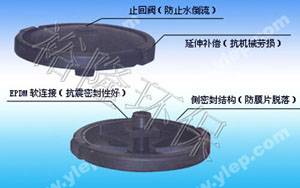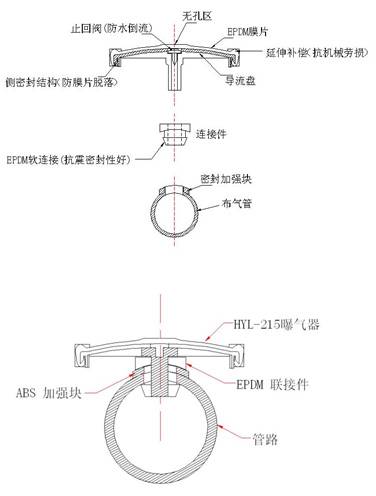product description
overview of product development
currently the aerator is widely used in
sewage treatment process. in addition to the large consumption, it is also the
core component of the sewage treatment process and can influence the operation
quality and the effluent characteristics of a sewage plant directly. 
in regard
to the traditional aerator, its tabular rubber diaphragm is tightly attached to
the plane mounting plate or the slightly raised mounting plate and is
compressed fast by a screw cover. the diaphragm of such aerator is extended and
stretched via the function of the elasticity of the rubber. and the stress
generated when aerating is mainly at the center of and around the diaphragm.
moreover, the stretch tensor is relatively small. as a result, the aeration
resistance is high and the diaphragm is liable to aging, which weakens the
oxygenation capacity, increases the power consumption and augments the workload
of maintaining and replacing the equipment.
to remedy the mentioned
shortcomings of the traditional aerator, our company, working together with
famous domestic colleges, has developed a new generation aerator, namely,
hyl-series disk-type rubber diaphragm microporous aerator. the patent number is:
product feature
※ the tabular rubber diaphragm of the traditional aerator
is changed for rubber diaphragms with compensation for extension, which can
remarkably increase the service life of the aerator.
※ the left-hand folding
structure of better sealing property is used between the diaphragm and the
mounting plate, which can effectively prevent the diaphragm from coming
off.
※ an internal check valve structure is designed for the diaphragm. with
no hole provided, the center of the diaphragm is thickened. when the valve is
closed to stop the air supply, the center part of the diaphragm can fall back
onto the hole of the supporting plate due to the water pressure and the
diaphragm’s elasticity. meanwhile, the area with no hole can cover exactly the
air release hole. that’s just like a check valve capable of preventing liquid
from flowing back into the aeration system.
※ an independent t-shape check
valve is provided inside the aerator, which can make sure no water will flow
into the pipelines even if the diaphragm is broken. hence, such kind of aerator
is perfectly suitable for intermittent aeration system, such as sbr
process.
※ the diaphragm is made from imported ethylene-propylene diene
copolymer (epdm), which makes the diaphragm anti-aging, corrosion-resisting and
durable.
※ bubbles generated during the aerating process are fine, that is,
their diameter is small, which can weaken the shear failure of sludge
particles.
※ an unique flexible connection type is used to connect the
aerator and the pipeline, which can effectively improve the sealing property and
prevent connecting pieces from breaking because of the vibration generated when
the aerator is in operation.
※ such kind of aerator can stand a temperature
of 150℃ at utmost and can be used for aeration in a pool where the water is as
deep as 10 m.
main uses and application scope
hyl-series microporous
aerator can be applied to the aeration oxygenation process in the treatment of
different types of sewage.
its performance indexes are totally up to the
provisions of cj/t3015.1-1993 and cj/t 264-2007.
| condition of using environment | can work in the environment air temperature 90 ~ 100 ℃ |
| ambient temperature of external climate | -30.0~45.0℃ |
| medium temperature | 4~50℃ |
| ph value | 4~9 |
| maximum immersion depth | 10.0m |
| work system | 24h/day continuous or intermittent work |
structural
features
hyl-series disk-type diaphragm microporous aerator is mainly made of
diaphragm, check valve, fixing ring and aerator tray.
the diaphragm of the aerator
is made from imported epdm, so it is efficient in resisting the ozone oxidation.
such kind of rubber can stand a high temperature up to 150℃ or a low temperature
down to -50℃. in addition, it can resist organic solvent and inorganic
substances effectively. and its compression resistance and elongation can be
respectively up to 25 mpa and 500%.
the diaphragm of the aerator consists of
2,700-6,600 micro pores. since a special one-step molding technology is
employed, the pores are uniform and the distribution of airflow on the whole
diaphragm is quite even, which guarantees the stability and all-sidedness of the
contact of airflow and sewage. when the aerator is in operation, the diameter of
the bubbles is even, ranging between 1 mm and 3 mm.
as for hyl-series
disk-type diaphragm microporous aerator, there is a downward-opening ring-type
groove at the outer edge of the back of the mounting plate. the side of the
diaphragm extends downward to buckle the groove at the back of the mounting
plate to form a seal structure, which enhances the sealing property of the
product and can effectively prevent the diaphragm from coming off. moreover,
there is an upward thickened convex edge at the top of the diaphragm, which can
compensate the extension and increase the service life.
there are two ways to
fix the hyl-series disk-type diaphragm microporous aerator to the air pipeline
system, namely, screw-type hard connection and stress expansion flexible
connection. typically, the latter way is adopted.
just like the diaphragm,
flexible connecting pieces are made of epdm as well. so they are of good shock
resistance and sealing property. hence, they can protect the junction from
breaking due to vibration caused by air blast, and meanwhile make the junction
more reliable and better sealed. moreover, retaining blocks are provided for the
pipelines to enhance the reliability of the flexible connection. at the same
time, the flexible connecting pieces are not fixed onto the pipelines with glue,
which makes the replacement or maintenance more convenient.
learn more technical information, please see the
manual